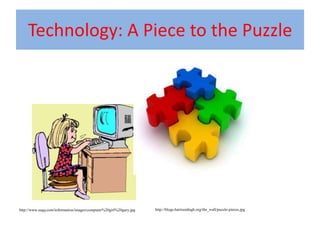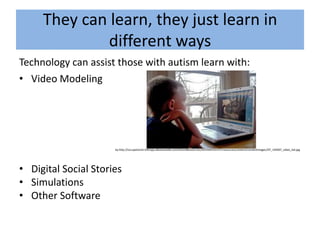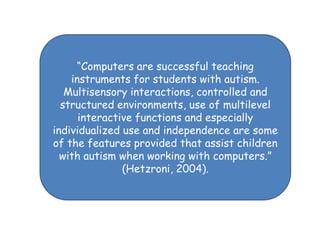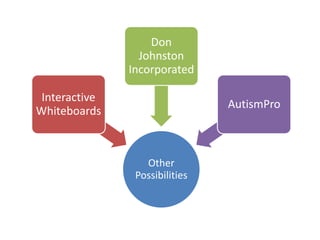Tech for autism
- 1. Technology: A Piece to the Puzzlehttp://www.ss/information/images/computer%20girl%20gary.jpghttp://blogs.harrisonhigh.org/the_wall/puzzle-pieces.jpg
- 2. Autism Spectrum DisorderAffects approximately 1.5 million people in the United States1 in every 110 children are diagnosed1 out of every 70 boysReason for increase in percentages is due to improved diagnosis and possible environmental factorsResearch is still in early stages; there is no definitive cause, only theoriesFive Disorders fall under the word Autism: Pervasive Developmental Disorder, Pervasive Developmental Disorder Not Otherwise Specified, Aspergerâs Syndrome, Rett Syndrome and Childhood Disintegrative Disorder
- 3. Just as every person is different, every person with Autism Spectrum Disorder is differenthttp://www.istockphoto.com/file_thumbview_approve/2673303/2/istockphoto_2673303-different-way.jpg
- 4. An autistic child has difficulty with communication and social interaction because they have trouble perceiving the world around them. Possible Social Differences:Lack of eye contactLack of personal interactionPreference to be aloneLack of understanding emotions, their own or othersPotential Communication Difficulties:Could be mute their entire lifeAdvanced vocabulary but unable to have two way communicationGesture or sign (nonverbal communication)
- 5. People with autism perceive the world in different wayshttp://www.udidahan.com/wp-content/uploads/fish-boy-cat-different-perspectives.jpg
- 6. They can learn, they just learn in different waysTechnology can assist those with autism learn with: Video Modeling by:http://occupational-therapy.advanceweb.com/sharedResources/ADVANCEforOT/resources/content/contentimages/OT_103007_video_kid.jpgDigital Social StoriesSimulationsOther Software
- 7. âComputers are successful teaching instruments for students with autism. Multisensory interactions, controlled and structured environments, use of multilevel interactive functions and especially individualized use and independence are some of the features provided that assist children with autism when working with computers.â (Hetzroni, 2004).
- 8. Video ModelingBenefits:Video can be replayed multiple timesSome scenarios would be difficult to create in the classroomTeacher has greater control of what is being portrayedThe television screen ânarrows the learning environment.â (Ayres and Langone, 2007.) Examples of Video Modeling:Hallway Greeting, http://www.youtube.com/watch?v=GF8uIDx-whIRaising Hand, http://www.youtube.com/watch?v=0Y4Qycgo__wTaking Turns, http://www.youtube.com/watch?v=aUKZ5VXyBYU
- 9. Charlop, Gilmore and Chang (2008) did a study on using video modeling to improve autistic childrenâs conversation skills. They based this study on the knowledge that the use of script cards had been effective in teaching conversation skills and video modeling had been effective in teaching other behaviors and skills. They found that after video modeling of conversation skills, their participants had increase variation in conversation skills and had an increase in generalization of those skills into their classroom.http://rocking-kids.webs.com/conversation.png
- 10. Ayres and Langone (2007) conducted a study testing the effects of video modeling on learning a social skill of putting groceries away.The participants were pretested, shown the video model and then tested again. http://gozone.net/images/st08-kids-computer-240-g-200299053-001.jpgIn all instances the participants improved in their abilities to put groceries away matching the first mentioned study in that video modeling can be an effective means of teaching autistic children communication and social skills.
- 11. Digital Social StoriesSocial Stories are âtools for teaching social skills to children with autism or other related disabilities.â (Wallins, 2004.)They are created to be specific to the individualDigital social stories create a multidimensional experience for the learnerNo Fighting Digital Social Story, http://www.youtube.com/watch?v=Zrg91eg63_I
- 12. More, 2008.
- 13. âDigital stories targeting social skills encompass effective teaching practices by involving multiple learning modes and using methods that can be embedded in the existing curriculum.â (Moore, 2008.)The benefits to using digital social stories matches what many have found about computer use in the classroom in that it increases motivation, aids students in staying on task and attention to task.http://www.computergames-for-kids.com/005-kids-with-computer.jpgThe multimedia social story follows the same structure of other social stories but is more attractive in the presentation because of the addition of digital pictures and sound. (Ozdemir, 2008)
- 14. SimulationHetzroni did a study using a program called I Can Word it Too which simulated areas of daily life like play, food and hygiene.
- 15. It was found that âpracticing simulated activities on the computer using familiar situations such as play, food and hygiene enhances use of appropriate functional communication in natural settings.â (Hetzroni, 2004).
- 16. The New York City School District set up a program for sixty of their students with autism spectrum disorder using a the program called Second Life, http://secondlife.com/.
- 17. The students increased their communication skills, expanded upon their social skills and practiced functional living skills from using this program.
- 18. Simulations are engaging ways to practice real life skills .
- 19. Interactive WhiteboardsEDTech Associates, http://www.edtech-associates.com/default.aspxTwo projects associating interactive whiteboards and autistic learners; Autism, Communication and Technology Project Autism and Technology ProjectBoth projects have studied the effects of using interactive whiteboards on teaching and learning in autistic studentsTheyâve found increased learning, better participation and behavior etc.The whiteboards have become the students âvoice.âhttp://1.bp.blogspot.com/_YtsL8K-BZhA/TDziCK3-JqI/AAAAAAAABMI/9RkbhgB2AgM/s1600/interactive-whiteboards2.jpg
- 20. Don Johnston IncorporatedOffers many different software programs to assist autistic students in the areas of social/environmental, symbol literacy, reading and phonics and writinghttp://www.donjohnston.com/autism/index.htmlSocial/Environmental, Faceland teaches facial expressions and emotionsSymbol literacy, Communicate SymWriter and Communicate: By Choice, both use symbols to assist children in writing, offer auditory support as well, can be used individually or with the classReading and Phonics, Start to Finish Literacy Starters offer paperback and computer books to help with reading AND Read: OutLoud 6 reads text out loud Writing, Co: Writer 6 helps build phrases and sentences AND Write: OutLoud 6 provides auditory support
- 21. AutismProhttp://www.autismpro.com/AutismPro has been developed to assist teachers of autistic children.They offer Professional Development online workshops, teaching resources, case management to track individual students, and intervention planning to individualize curriculum to the childâs specific needs.AutismPro can be purchased for schools and is endorsed by the Council of Administrators of Special Education
- 22. Computers = the future success of people with AutismLearning environment can be narrowedStudents are better able to focus Comfortable and engagingSatisfying sensory experienceGood way for teachers to differentiate instructionhttp://www.personal.psu.edu/aes284/twtc/images/computer.jpg
- 24. ReferencesAutismPro. (2010). Retrieved on November 15th, 2010 from http://www.autismpro.com/.Autism Speaks Inc. (2010). Retrieved on November 2nd, 2010, from http://www.autismspeaks.org/about_us.phpAyres, K., & Langone, J. (2007). A Comparison of Video Modeling Perspectives for Students with Autism. Journal of Special Education Technology, 22(2), 15-30. Retrieved from Education Research Complete database.Charlop, M., Gilmore, L., & Chang, G. (2008). Using Video Modeling to Increase Variation in the Conversation of Children with Autism. Journal of Special Education Technology, 23(3), 47-66. Retrieved from Education Research Complete database.Don Johnston Incorporated. (2010). Retrieved on November 15th, 2010 from http://www.donjohnston.com/.EDTech Associates. (2009). Helping Schools and Students Become Successful with Technology. Retrieved on November 15th, 2010 from http://www.edtech-associates.com/default.aspx. Hetzroni, O., & Tannous, J. (2004). Effects of a Computer-Based Intervention Program on the Communicative Functions of Children with Autism. Journal of Autism & Developmental Disorders, 34(2), 95-113. Retrieved from Education Research Complete database.More, C. (2008). Digital Stories Targeting Social Skills for Children With Disabilities: Multidimensional Learning. Intervention in School & Clinic, 43(3), 168-177. Retrieved from Education Research Complete database.Ozdemir, S. (2008). USING MULTIMEDIA SOCIAL STORIES TO INCREASE APPROPRIATE SOCIAL ENGAGEMENT IN YOUNG CHILDREN WITH AUTISM. Turkish Online Journal of Educational Technology, 7(3), 80-88. Retrieved from Education Research Complete database.Stroud, S. (2009). A NEW WAY forward. T H E Journal, 36(10), 18-22. Retrieved from Education Research Complete database.Wallin, J. (2004). Teaching Children with Autism. Polyxo.com. Retrieved on November 10th, 2010 from http://www.polyxo.com/socialstories/introduction.html.




















